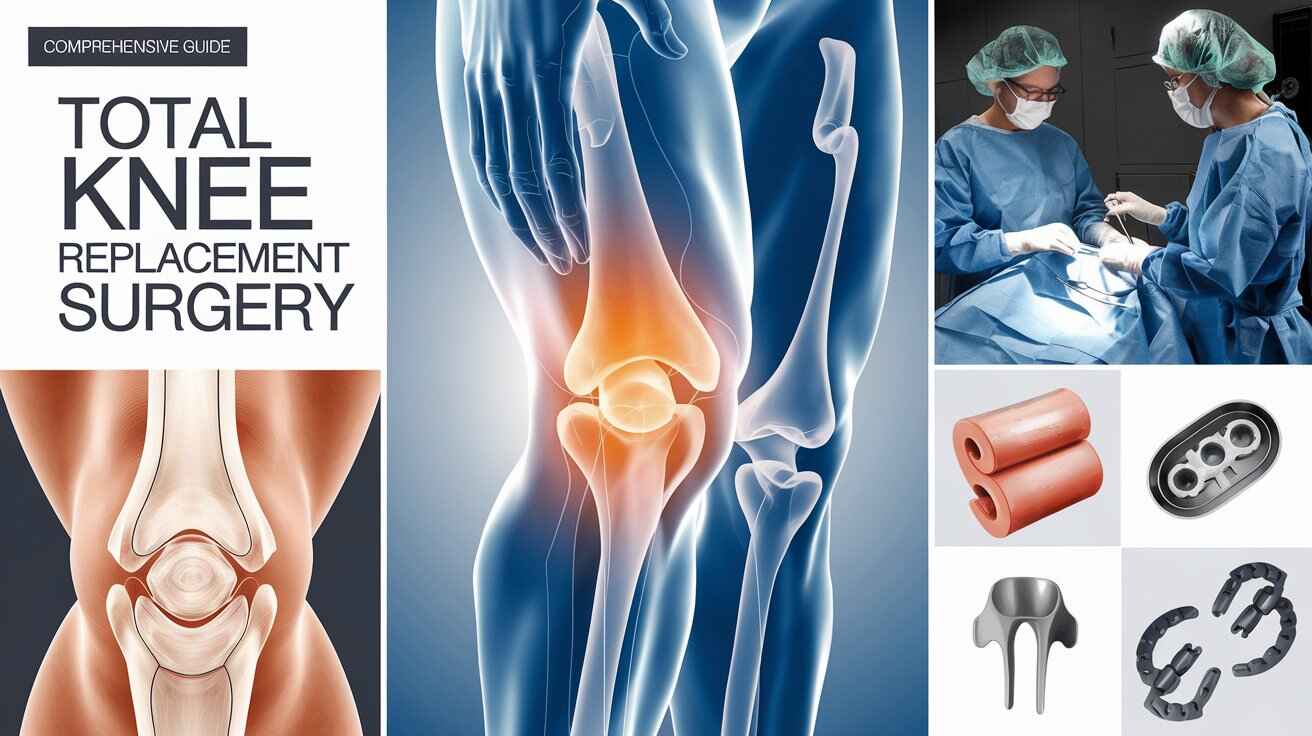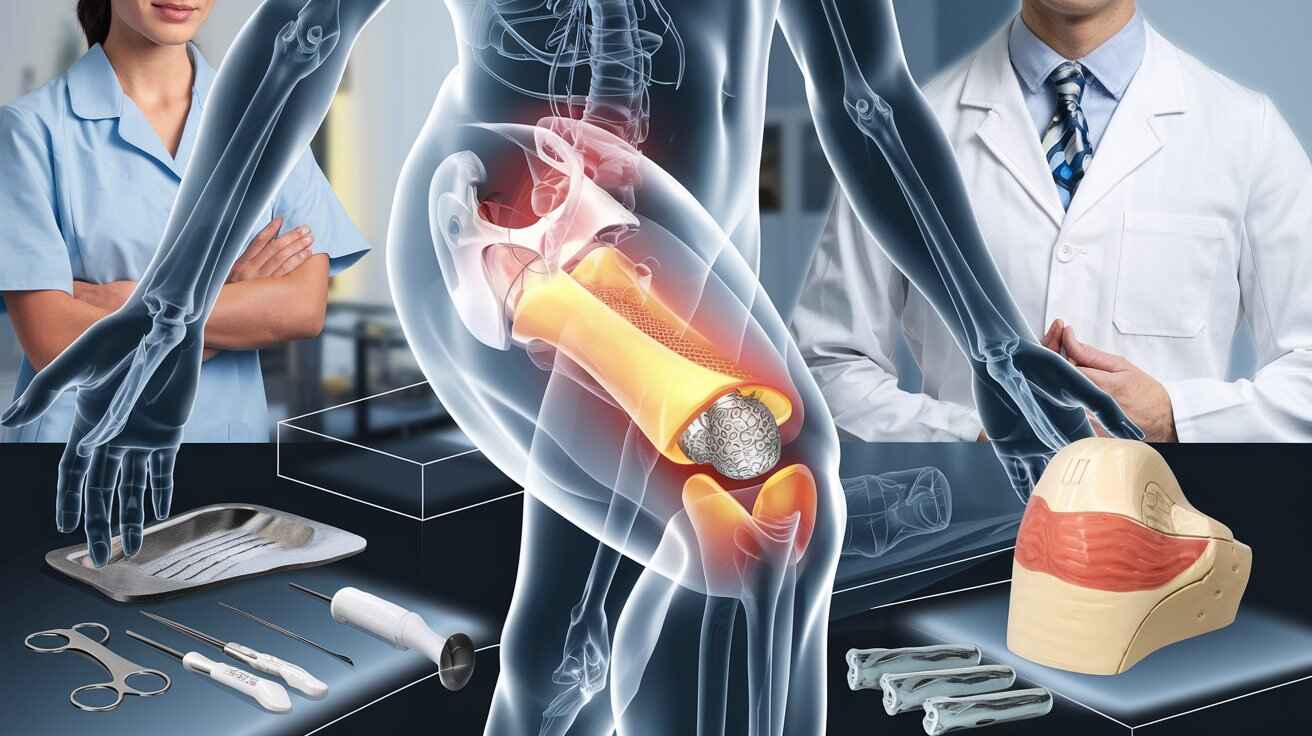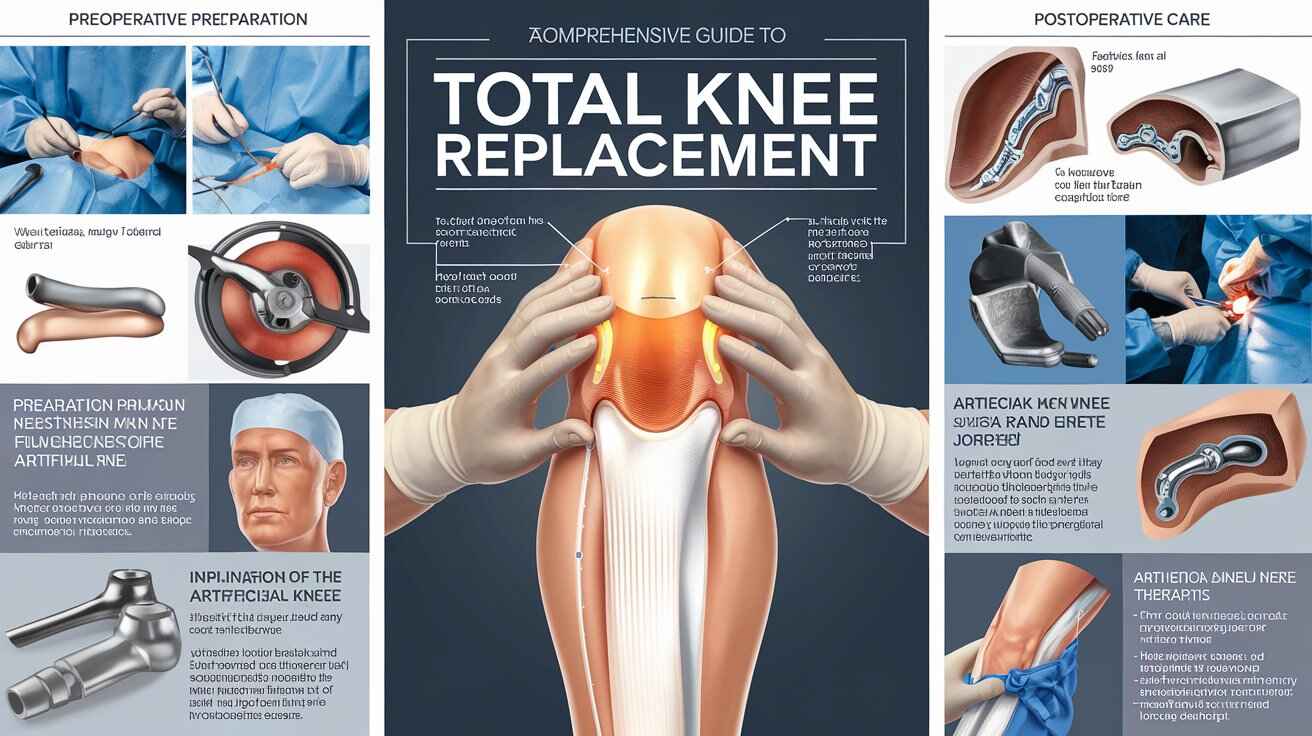Understanding the Basics of Knee Replacement
When knee pain impacts your daily activities and quality of life, seeking appropriate treatment and management strategies becomes essential. Overall quality of life, you may consider total knee replacement as a potential solution. For many patients who have severe arthritis or knee injuries, this surgical procedure represents a path back to mobility and comfort after years of progressive pain and limitation.
At Dr. Debashish Chanda's practice, we informed patients to make better healthcare decisions. This comprehensive guide will explain a total knee replacement, how the procedure works, who needs it, what to expect during Recovery, and much more. Whether considering this surgery for yourself or supporting a loved one through the process, this information will help you confidently navigate the journey.
What Is a Total Knee Replacement?

Total knee replacement (TKR), or total knee arthroplasty, is a surgical procedure that involves replacing the damaged surfaces of the knee joint with artificial components. It is a surgical procedure to reduce pain and restore functionality in a knee joint severely damaged or affected by arthritis. It is a surgical procedure intended to relieve pain and restore function in the knee. Function in patients with severe knee damage or arthritis. The method entails the removal of damaged parts. The text can be rewritten as:
"Replacement of the knee joint and its components with artificial parts" replicates a healthy knee's function. Despite the name "replacement," the entire knee is not replaced—instead, the damaged surfaces of the joint are resurfaced with prosthetic components.
The Anatomy of a Knee Replacement
A total knee replacement typically consists of three main components:
- Femoral component: A metal piece that curves around the end of the thigh bone (femur) and replaces the damaged cartilage and bone on the lower end of this bone.
- Tibial component: A flat metal platform with a stem attached to the top of the shin bone (tibia), replacing the damaged surface of this bone.
- Polyethylene insert: A high-grade plastic spacer that sits between the metal components and acts as artificial cartilage, allowing smooth movement between the femur and tibia.
In some cases, a fourth component may be used to resurface the underside of the kneecap (patella), though this isn't always necessary, depending on the condition of this joint surface.
Materials Used in Modern Knee Replacements
Today's knee implants are made from advanced materials designed for durability and biocompatibility:
- Metals: Often cobalt-chromium alloys or titanium, chosen for their strength and resistance to corrosion
- Plastics: Usually ultra-high-molecular-weight polyethylene (UHMWPE), engineered to minimize wear over decades of use
- Ceramic: Sometimes used for specific components, offering excellent wear characteristics
Dr. Chanda carefully selects the most appropriate implant system for each patient based on age, activity level, anatomy, and specific needs.
Why Would Someone Need a Total Knee Replacement?

The primary reason for requiring a total knee replacement is osteoarthritis, the gradual deterioration of joint cartilage that causes pain, stiffness, and reduced function. However, several conditions can lead to knee joint damage that might eventually require replacement:
Common Conditions Leading to Knee Replacement
- Osteoarthritis: Age-related degeneration of joint cartilage, often affecting people over 50
- Rheumatoid arthritis: An autoimmune condition causing chronic inflammation that damages joint surfaces
- Post-traumatic arthritis: Develops after serious knee injuries like fractures or ligament tears
- Avascular necrosis is a condition in which blood supply to a bone is lost, potentially leading to the death of bone tissue. Supply to the bone. Interrupted, leading to bone death and collapse
- Knee deformities: Such as bowed legs (varus) or knock-knees (valgus) that progressively worsen over time
Signs You Might Need a Knee Replacement
While only a qualified orthopedic surgeon like Dr. Chanda can determine if you're a candidate for surgery, common indicators include:
- Persistent pain even while resting or at night
- Daily activities, including walking, climbing stairs, and getting in and out of chairs, are significantly limited. Knee stiffness restricts normal movement.
- Chronic swelling that doesn't improve with rest or medications
- Failed response to conservative treatments like physical therapy, medications, injections, or bracing
- X-rays showing advanced joint damage or bone-on-bone contact
How Does a Total Knee Replacement Work?
The knee is a hinge joint that permits movement in one direction, enabling bending, straightening, and limited rotation. A successful knee replacement recreates this complex motion while providing stability and pain relief. The artificial components work together to allow bending, straightening, and the slight rotational movements needed for normal function.
The Biomechanics of an Artificial Knee
When functioning correctly, your new knee joint:
- Allows smooth gliding movement between the femoral and tibial components
- Distributes weight evenly across the joint surfaces
- Maintains proper alignment during movement
- Provides stability through preserved ligaments and balanced muscle tension
- Absorbs shock through the polyethylene spacer
Modern implant designs aim to closely mimic natural knee movement patterns, though no artificial joint perfectly matches the complexity of human biology. Dr. Chanda's surgical expertise ensures optimal component positioning and soft tissue balancing for the best functional outcome.
The Total Knee Replacement Procedure: Step by Step

Understanding the surgical process can help alleviate anxiety about the procedure. Here's what typically happens during a total knee replacement:
Before Surgery
- Pre-operative assessment: Medical evaluation, testing, and clearance to ensure you're healthy enough for surgery
- Pre-operative planning: Dr. Chanda will take measurements, possibly using imaging techniques like CT scans, to plan precise implant placement
- Preparation: Instructions about medications, fasting requirements, and what to bring to the hospital
During Surgery
- Anesthesia: Either general anesthesia (you're asleep) or spinal/epidural anesthesia (you're awake but feel no pain below the waist)
- Incision: A vertical incision approximately 6-10 inches long is made down the front of the knee
- Exposure: The kneecap (patella) is moved aside to access the joint.
- Bone preparation: Damaged cartilage and a small amount of bone are removed from the femur, tibia, and sometimes the patella.
- Component placement: The artificial components are positioned, either with bone cement or using press-fit techniques that allow bone to grow into the implant
- Testing: The knee is bent and flexed to ensure proper alignment, stability, and range of motion
- The incision is closed with stitches or staples, and a bandage is applied afterward.
The entire procedure typically takes 1-2 hours. Certain patients may qualify for minimally invasive techniques involving smaller incisions, potentially reducing recovery time.
Advanced Surgical Techniques
Dr. Chanda employs several advanced techniques when appropriate:
- Computer-assisted surgery: Using specialized software to guide precise implant placement
- Patient-specific instrumentation: Custom cutting guides created from pre-operative imaging
- Kinematic alignment: A technique focusing on restoring the knee's natural alignment rather than using standardized parameters
- Robotic-assisted surgery: In some cases, robotic systems help execute the surgical plan with extreme precision
These approaches may benefit specific patients, though conventional techniques remain highly effective when performed by an experienced surgeon like Dr. Chanda.
Cost Factors for Total Knee Replacement
Many patients need to consider the cost of knee replacement, which can vary significantly based on several factors.
What Influences the Cost?
- Geographic location and facility fees
- Surgeon's experience and expertise
- Type of implant used
- Length of hospital stay
- Anesthesia services
- Pre-operative testing requirements
- Post-operative care needs, including physical therapy
Insurance Coverage
Most health insurance plans, including Medicare, cover knee replacement surgery when medically necessary. However, coverage details vary significantly between plans:
- Deductibles: The amount you must pay before insurance begins covering costs
- Co-insurance: The percentage of costs you're responsible for after meeting your deductible
- Co-pays: Fixed amounts paid for specific services
- Out-of-pocket maximums: The total amount you might need to pay in a calendar year
- Network restrictions: Coverage differences between in-network and out-of-network providers
Dr. Chanda's office staff can help you understand your specific coverage and potential out-of-pocket expenses. Many facilities also offer payment plans or financing options for patients facing significant costs.
Benefits of Total Knee Replacement
For appropriate candidates, knee replacement surgery offers numerous potentially life-changing benefits:
Physical Benefits
- Pain relief: Most patients experience significant reduction or complete elimination of chronic knee pain
- Improved mobility: Ability to walk, climb stairs, and perform daily activities with greater ease
- Increased stability: Reduction in feelings of buckling or giving way
- Correction of deformity: Improvement in leg alignment for patients with severe bow-legged or knock-kneed conditions
- Enhanced endurance: Ability to walk longer distances without pain or fatigue
Quality of Life Benefits
- Greater independence: Less reliance on pain medications, assistive devices, or help from others
- Improved sleep: Less pain disruption during night hours
- Enhanced mental health: Decreased symptoms of depression and anxiety. Associated with chronic pain.
- Return to activities: Ability to participate in many recreational activities like walking, swimming, cycling, and golf
- Social reengagement: Increased participation in family and community activities
Research consistently shows high satisfaction rates, with approximately 90% of patients reporting good to excellent outcomes following knee replacement surgery.
Potential Risks and Complications
Like any major surgery, total knee replacement carries certain risks. It's important to understand these possibilities while keeping them in perspective:
Surgical Risks
- Infection: Occurs in approximately 1-2% of patients
- Blood clots: Preventable with medication and early mobilization
- Damage to nerves or blood vessels is rare but can occur during surgery.
- Implant problems: Issues with loosening, wear, or alignment over time
- Persistent pain or stiffness May require additional intervention
- Need for revision surgery: Some implants may eventually wear out or develop problems
Dr. Chanda takes numerous precautions to minimize these risks, including antibiotics, blood thinners, careful surgical technique, and thorough post-operative monitoring.
Recovery and Rehabilitation After Knee Replacement
Recovery from knee replacement is a process that unfolds over several months, with different milestones along the way:
Hospital Stay and Early Recovery (Days 1-14)
- Hospital stay: Typically 1-3 days
- Pain management: Medications to control post-operative pain
- Early mobilization: Standing and walking with assistance the day of or the day after surgery
- Initial physical therapy: Learning exercises and proper movement techniques
- Discharge planning: Preparation for home recovery or short-term rehabilitation stay
Recovery at Home (Weeks 2-6)
- Ongoing physical therapy can be performed at home or in an outpatient setting.
- Walking progression: Gradually increasing distance and decreasing dependence on assistive devices
- Exercise regimen: Following prescribed strengthening and range-of-motion exercises
- Pain management: Transitioning to oral pain medications
- Wound care: Monitoring healing and removing stitches or staples
Intermediate Recovery (Weeks 6-12)
- Advanced exercises: Increasing strength and endurance
- Return to light activities: Resuming many normal daily functions
- Driving: Usually permitted when off narcotic pain medications and with adequate control of the operative leg
- Follow-up appointments: Checking progress and implant position
Long-Term Recovery (3-12 months)
- Continued strengthening: Focusing on muscle development around the knee
- Activity expansion: Gradually returning to more demanding activities as approved
- Scar maturation: Continued fading and softening of the surgical scar
- Maximum improvement: Reaching your full potential with the new joint
Tips for Successful Recovery
Dr. Chanda recommends the following strategies for optimal Recovery:
- Follow all post-operative instructions carefully
- Participate actively in physical therapy sessions
- Perform home exercises as prescribed
- Use cold therapy to manage swelling
- Keep a healthy weight to lessen the strain on your new joint.
- Eat a nutritious diet to support healing
- Remain positive and patient throughout the recovery process.
- Report any concerns promptly to your healthcare team.
Most patients can expect significant improvement within 3 months, though complete Recovery may take a full year. Remember that each patient's recovery timeline is unique.
Frequently Asked Questions About Total Knee Replacement
How long will my new knee last?
Modern knee replacements typically last 15-20 years or more. Factors affecting longevity include age, activity level, weight, and how well the surgery performed. Younger, more active patients may eventually need revision surgery if they outlive their implant.
When can I return to work after knee replacement?
Return-to-work timing depends on your occupation. Office workers can often return within 4-6 weeks, while those with more physically demanding jobs may need 3 months or longer. Dr. Chanda will provide specific guidance based on your situation.
"Will my new knee set off metal detectors?"
Many modern knee implants will trigger airport security systems. The Transportation Security Administration (TSA) regularly screens people with joint replacements. While not typically necessary, some patients feel more comfortable carrying a card from their surgeon confirming their implant.
What activities can I do after Recovery?
Most patients can return to low-impact activities like walking, swimming, cycling, golf, and dancing. High-impact activities like running, jumping, and contact sports are usually discouraged because they can reduce the lifespan of implants. Dr. Chanda will provide personalized guidance based on your situation and implant type.
Is there an alternative to total knee replacement?
For some patients, alternatives may include:
- Continued conservative treatment: Physical therapy, medications, and injections
- Partial knee replacement: Replacing only the damaged portion of the knee
- Osteotomy: Realigning the leg by removing or adding a wedge of bone
- Cartilage restoration procedures: Various techniques to repair damaged cartilage
Dr. Chanda can discuss whether these options suit your specific condition.
Conclusion: Is Total Knee Replacement Right for You?
Total knee replacement has enabled millions to enjoy a more active, pain-free life. The choice to undergo this procedure is personal and should be made in consultation with a qualified orthopedic surgeon like Dr. Debashish Chanda.
If knee pain is limiting your activities, affecting your mood, or reducing your quality of life despite conservative treatments, it may be time to discuss surgical options. Modern techniques, improved implant materials, and enhanced rehabilitation protocols have made knee replacement safer and more effective.
We invite you to schedule a consultation with Dr. Chanda to evaluate your knee condition and discuss whether total knee replacement could help you return to the activities you enjoy. Our team is committed to providing personalized care throughout your orthopedic journey.






